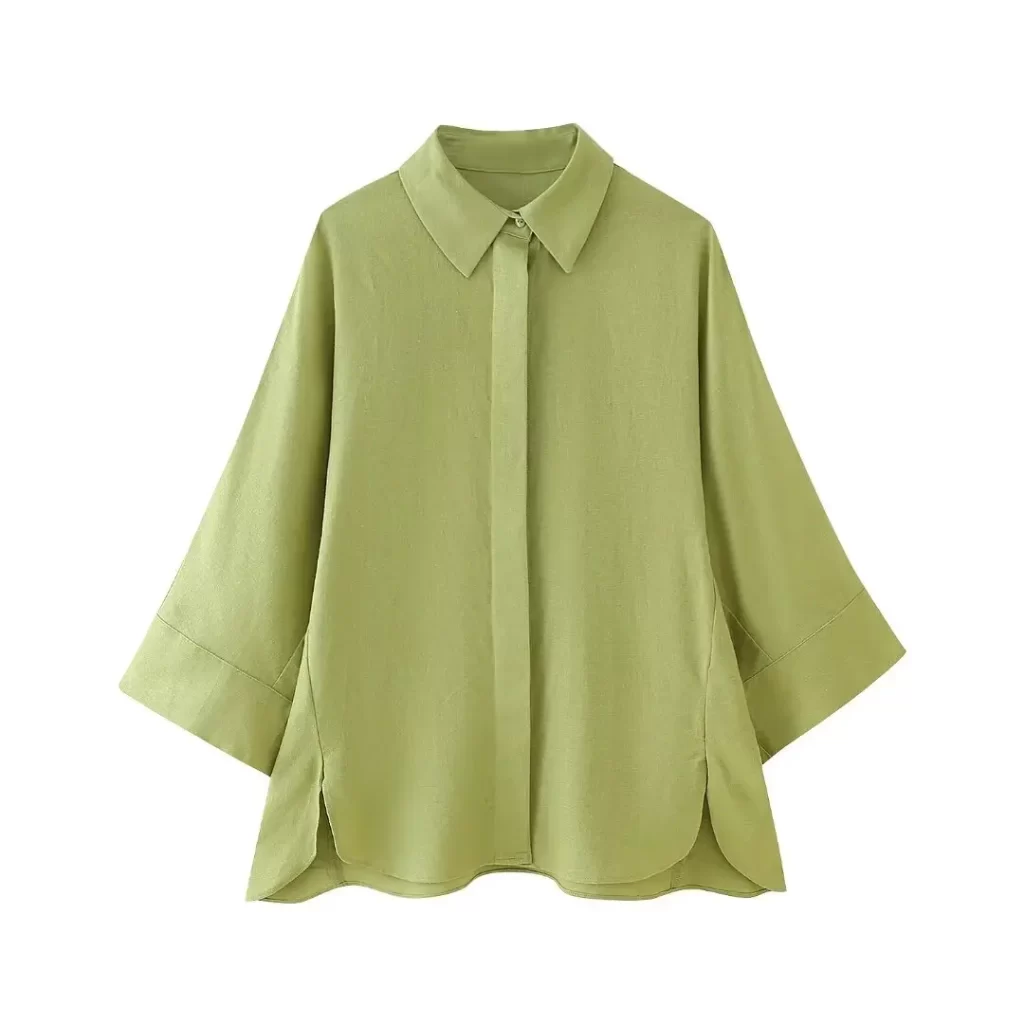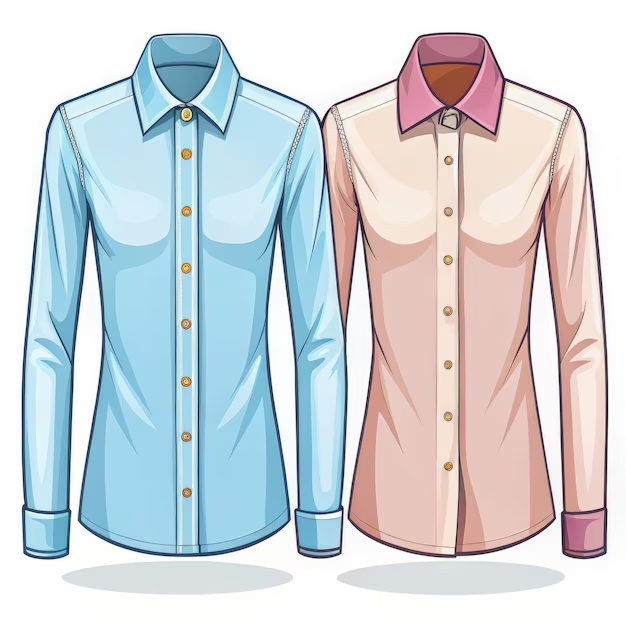Historical Significance of Buttons and Gender
Long ago, buttons showed wealth and social rank. Men’s shirt buttons were on the right. Women’s buttons were on the left. This was not by chance but linked to societal norms and roles. High-status men often dressed themselves. Having buttons on the right side made this easier for them. Wealthy women had maids for dressing. For a right-handed maid, buttons on the left side were more practical. Over time, these details in clothing became a subtle sign of affluence. Experts say there’s no official reason for this design choice. Yet, it reflects past customs where clothing detailed one’s place in society.
The Origin of Distinct Button Sides for Men and Women
The reason why men’s and women’s shirts have buttons on opposite sides goes back centuries. While there is no single, documented explanation for this separation, fashion historians have proposed some convincing theories. The use of buttons as a luxury item had class implications. Wealthy individuals could afford to decorate their clothes with expensive buttons. Because buttons reflected social status, their placement took on added importance.
Men have historically dressed themselves. Therefore, having buttons on the right side allowed for easier fastening with the dominant right hand. Wealthier women, conversely, employed maids to assist with the complex process of dressing. With layered garments, a maid, typically right-handed, would find it simpler to fasten buttons on the left side of her lady’s outfit.
Additionally, the design of women’s clothing often included intricate details and decorations. These adornments required more attention and time to fasten, especially when an attendant was dressing her mistress. As such, the functionality of button placement catered primarily to the convenience of those assisting with the dressing rather than the wearer herself.
This separation of button sides based on gender soon became an accepted standard. It represented not only ease of dress but also the social hierarchy of the time. While buttoned garments became more common and less tied to wealth, the tradition of distinct button sides for men and women remained entrenched in fashion design.
As we explore this subject further, it becomes increasingly apparent that the origins of such sartorial norms were shaped heavily by the societal structures of the past. This historical approach to button placement has been preserved, even as the reasons for its inception have faded. The persistence of gender-specific buttons serves as an enduring reminder of the ways in which fashion reflects social customs and the dynamics of power and servitude.

Societal Status and Button Placement
Buttons once indicated wealth and social rank, leading to different placements for men and women. Men typically clothed themselves, so buttons on the right side made sense. Women of high societal status had maids dress them, making left-side buttons more practical for the right-handed assistant. As such, the side where buttons appeared became an indirect symbol of one’s social standing.
In this context, button placement was not just a functional detail but also a statement of wealth and privilege. The distinct sides served a dual purpose: they made dressing easier based on societal roles and subtly communicated the wearer’s status. Over time, these practices were normalized, creating a tradition in clothing design that has persisted even after the original reasons became outdated.
Today, while wealth is not judged by button sides, the age-old arrangement remains. It stands as a historical reminder of the past, and how fashion has long been intertwined with social hierarchies. This small, seemingly insignificant design feature thus carries with it a rich tapestry of history and social cues.
The Role of Maids in Women’s Fashion
The buttons on a woman’s shirt tell a story, not just of style but of history and service. Maids played a crucial role in the fashion of affluent women. In the past, wealthy women wore lavish gowns and layers. These required careful and skilled dressing, often by a servant. Having buttons on the left side was a matter of practicality for a right-handed maid. This setup allowed them to dress their mistresses with more ease and efficiency.
For maids, ease of buttoning was paramount. They had to work quickly and smoothly to prepare the ladies for the day. Buttons on the left side meant less awkwardness for the right-handed majority. They needed to deftly manage multiple layers, from petticoats to corsets. The placement of buttons was a small but vital part of their daily routine.
This detail of button orientation, though seemingly minor, has survived through time. It has become a part of women’s fashion tradition. Even today, with no maids to assist, the legacy of left-sided buttons on women’s shirts continues. When we button up a woman’s shirt, we echo the motions dictated by a history of servitude and status.
The historical connection between maids and the dressing process has faded. Yet, the design choice remains a nod to the elaborate and class-based fashions of the past. It serves as a reminder of the time when fashion was not just about the look but also about the practicality for those behind the scenes – the maids.

The Evolution of Button Placement in Modern Times
The tradition of button placement on shirts has carried from the past to modern times. Despite changes in society and fashion, the distinct sides for buttons on men’s and women’s shirts remain. This practice started in the 13th and 14th centuries and has lasted through the centuries. Today, button placement is less about status and more about design.
Clothes now have buttons as a standard feature, not a luxury. The materials for buttons may vary and add to style. Yet, the side the buttons are on no longer signals wealth.
Men’s and women’s clothing still reflects historical patterns, even though reasons have changed. Designers continue to create based on these old standards. But, some question these traditions. They propose styles that suit everyone, no matter which hand they use.
Now, people use buttons without thinking about their significance. Most are unaware that button direction is linked to gender. They see it as a simple design choice, not a nod to history. Manufacturers also have a role. They produce shirts with standard button placement. This helps streamline the process and reduce confusion on production lines.
For many, the topic of button orientation is just a quirky fact. But for those in fashion, it’s a link to the past. It shows how traditions can endure, even when their original purpose is gone. Some in the industry wish to challenge the norm and innovate. They aim to make fashion inclusive and break old molds. This could lead to changes in button placement in the future.
As fashion evolves, we may see a shift. Button placement may become a choice of practicality and personal preference, not tradition. This change would mark a significant step in the journey of fashion design.
Design Legacy and Future of Gender-Specific Buttons
The distinct button placement has a long history. Women’s shirts with buttons on the left hark back to maids dressing wealthy ladies. Men’s shirts with right-side buttons suited self-dressing. This design has outlasted its practical reasons.
Button placement now stems from tradition, not necessity. Yet, it stays unchanged in most modern clothing. Some fashion designers question this old standard. They suggest unisex styles, with practicality for all users in mind.
In manufacturing, standard placements help. They keep production clear and efficient. But, a trend towards customisation might disrupt this. Innovative designers are pushing for change. They want fashion that reflects current needs, not just past practices.
As society progresses, gender-specific buttons could evolve. They might become a personal choice, rather than a design default. This change would reflect a modern view of fashion. It would allow for more inclusive and practical clothing options.
In conclusion, the design legacy of button placement is notable. But its future might see a shift. Fashion could move towards styles that are more practical and inclusive. This would match the evolving nature of contemporary society and its fashion.

Practical Implications and Manufacturing Standards
The function of women’s shirts goes beyond mere aesthetic appeal; it has practical implications in manufacturing. When it comes to producing clothing, consistency is key. Having a standard for button placement—right side for men’s shirts, left for women’s—simplifies the process. It aids assembly line workers in quickly identifying the garment type they are working on.
Standardized button placement also speeds up quality control. It reduces errors during the sewing process. A set guideline for button placement helps maintain uniformity across different sizes and styles. What’s more, this consistency makes inventory management easier for retailers. They can quickly sort and display their merchandise.
Despite these manufacturing benefits, the question stands: should tradition dictate current-day fashion? Some designers argue that times have changed. They say that fashion should reflect the present, not just the past. As a result, we see a slow but steady push for innovation in button placement. This shift looks towards a more flexible, user-friendly approach.
In an industry where customization is becoming a priority, considering both left- and right-handed users could lead to more inclusive design choices. These choices could break away from the gender-based standards that have been in place for centuries. Ultimately, it is about finding a balance. Producers must weigh the benefits of standardization against the desire for innovation and personalization in fashion.
The future of button placement might hold a range of options. These could cater to individual preferences while still considering the practical needs of production and sale. In the meantime, the debate continues. Should we stick to tradition, or is it time to rethink button standards to align with the evolving demands of consumers?
Rethinking Button Placement in Contemporary Fashion
The design of women’s shirts with buttons on the left and men’s on the right has deep historical roots. However, as we move into contemporary fashion, the question arises: is it time to rethink button placement? Here’s why contemporary designers might consider shaking up this long-standing tradition.
Firstly, there’s inclusivity. Not everyone is right-handed. Left-handed individuals may struggle with traditional button placement. Adopting a more neutral stance could make dressing more accessible.
Then there’s the question of gender fluidity. Traditional gender norms in clothing are blurring. Clothing that favors function over gender can align with these changing societal attitudes. It may lead to more unisex designs, where the side buttons appear is a non-issue.
There’s also personal preference. Some people might find one side easier to use over the other. Fashion choices that cater to individual needs show an understanding of diverse markets.
Despite these considerations, manufacturing standards still favor tradition for a reason. Uniform button placement simplifies production. It keeps costs down and processes efficient. Balancing customization with these practical aspects is a challenge for the industry.
Some designers are taking the first steps toward change. They offer garments with buttons on either side, or no buttons at all. Innovation is key in modern fashion. As such, we may see more adaptive and inclusive designs emerge.
In sum, rethinking button placement is about more than changing a fashion detail. It’s about catering to a wider audience and reflecting a modern, inclusive society. It’s a small shift that could signify bigger changes in the world of fashion.
